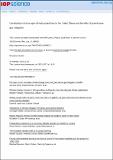| dc.contributor.author | Snyder, Richard | |
| dc.contributor.author | Monier, Erwan | |
| dc.contributor.author | Monier, Liyi Xu | |
| dc.date.accessioned | 2017-02-23T20:16:57Z | |
| dc.date.available | 2017-02-23T20:16:57Z | |
| dc.date.issued | 2016-04 | |
| dc.date.submitted | 2016-03 | |
| dc.identifier.issn | 1748-9326 | |
| dc.identifier.uri | http://hdl.handle.net/1721.1/107137 | |
| dc.description.abstract | Scientific challenges exist on how to extract information from the wide range of projected impacts simulated by crop models driven by climate ensembles. A stronger focus is required to understand and identify the mechanisms and drivers of projected changes in crop yield. In this study, we investigate the robustness of future projections of five metrics relevant to agriculture stakeholders (accumulated frost days, dry days, growing season length, plant heat stress and start of field operations). We use a large ensemble of climate simulations by the MIT IGSM-CAM integrated assessment model that accounts for the uncertainty associated with different emissions scenarios, climate sensitivities, and representations of natural variability. By the end of the century, the US is projected to experience fewer frosts, a longer growing season, more heat stress and an earlier start of field operations—although the magnitude and even the sign of these changes vary greatly by regions. Projected changes in dry days are shown not to be robust. We highlight the important role of natural variability, in particular for changes in dry days (a precipitation-related index) and heat stress (a threshold index). The wide range of our projections compares well the CMIP5 multi-model ensemble, especially for temperature-related indices. This suggests that using a single climate model that accounts for key sources of uncertainty can provide an efficient and complementary framework to the more common approach of multi-model ensembles. We also show that greenhouse gas mitigation has the potential to significantly reduce adverse effects (heat stress, risks of pest and disease) of climate change on agriculture, while also curtailing potentially beneficial impacts (earlier planting, possibility for multiple cropping). A major benefit of climate mitigation is potentially preventing changes in several indices to emerge from the noise of natural variability, even by 2100. This has major implications considering that any significant climate change impacts on crop yield would result in nation-wide changes in the agriculture sector. Finally, we argue that the analysis of agro-climate indices should more often complement crop model projections, as they can provide valuable information to better understand the drivers of changes in crop yield and production and thus better inform adaptation decisions. | en_US |
| dc.description.sponsorship | United States. Environmental Protection Agency (Climate Change Division, Cooperative Agreement # XA-83600001) | en_US |
| dc.description.sponsorship | United States. Department of Energy (Office of Biological and Environmental Research, grant DE-FG02-94ER61937) | en_US |
| dc.description.sponsorship | National Science Foundation (U.S.) (Macrosystems Biology Program Grant # EF1137306) | en_US |
| dc.language.iso | en_US | |
| dc.publisher | Institute of Physics Publishing (IOP) | en_US |
| dc.relation.isversionof | http://dx.doi.org/10.1088/1748-9326/11/5/055001 | en_US |
| dc.rights | Creative Commons Attribution 3.0 License | en_US |
| dc.rights.uri | http://creativecommons.org/licenses/by/3.0/ | en_US |
| dc.source | IOP Publishing | en_US |
| dc.title | Uncertainty in future agro-climate projections in the United States and benefits of greenhouse gas mitigation | en_US |
| dc.type | Article | en_US |
| dc.identifier.citation | Monier, Erwan, Liyi Xu, and Richard Snyder. “Uncertainty in Future Agro-Climate Projections in the United States and Benefits of Greenhouse Gas Mitigation.” Environmental Research Letters 11, no. 5 (April 26, 2016): 055001. | en_US |
| dc.contributor.department | Massachusetts Institute of Technology. Center for Global Change Science | en_US |
| dc.contributor.department | Massachusetts Institute of Technology. Joint Program on the Science & Policy of Global Change | en_US |
| dc.contributor.mitauthor | Monier, Erwan | |
| dc.contributor.mitauthor | Monier, Liyi Xu | |
| dc.relation.journal | Environmental Research Letters | en_US |
| dc.eprint.version | Final published version | en_US |
| dc.type.uri | http://purl.org/eprint/type/JournalArticle | en_US |
| eprint.status | http://purl.org/eprint/status/PeerReviewed | en_US |
| dspace.orderedauthors | Monier, Erwan; Xu, Liyi; Snyder, Richard | en_US |
| dspace.embargo.terms | N | en_US |
| dc.identifier.orcid | https://orcid.org/0000-0001-5533-6570 | |
| dc.identifier.orcid | https://orcid.org/0000-0003-2693-113X | |
| mit.license | PUBLISHER_CC | en_US |
| mit.metadata.status | Complete | |
